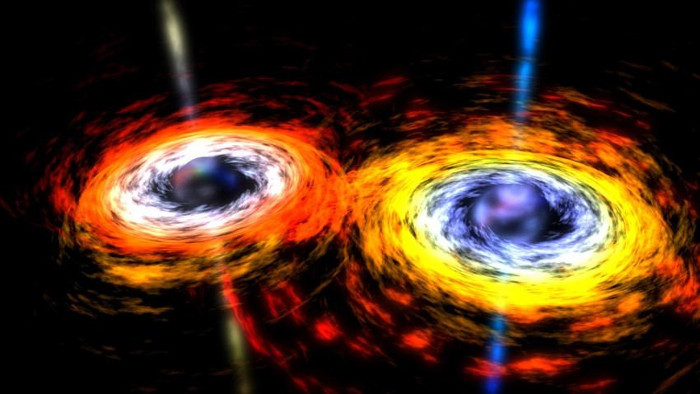Detecting the supermassive black hole is spraying material
Scientists use NASA's Chandra X-ray telescope to detect a supermassive black hole in the center of a nearby galaxy.
This black hole seems to be "spraying" material, after draining all the material near it. This phenomenon may have contributed to the formation of the early universe.
New research results of scientists have been presented at the meeting of the American Astronomical Society (AAS) in Florida on January 5, and published in the Astrophysical Journal near. here.
According to the study, scientists discovered that a black hole is spewing out two glowing gases and matter, near the center of NGC 5195 , a small galaxy located from our galaxy (Milky Way). ) about 27 light years. This galaxy is in the process of merging with another galaxy, named NGC 5194 , creating a large spiral in the universe.

The image simulates two merging black holes, both spewing out bright streams of matter.(Source: NASA).
Astronomer Eric Schlegel at the University of Texas (USA) said at the meeting of AAS: " We think this happens very often in the early universe . At that time the galaxies are" crowded ". At high density, they often collide and you will see the air gushing out like this. "
Schlegel said that these light streams were created from materials that were thrown during the merger of the two galaxies.
In a related study, scientists also discovered a supermassive black hole that stars surrounding it might be attracted to a companion black hole. This black hole pair, located about 1 billion light-years from the Solar System, is located in the SDSS galaxy J1126 + 2944.
This pair of rare black holes (belonging to one of the 12 galaxies known to contain two supermassive black holes) is most likely the result of two merging galaxies, astrophysicist Julie Comerford at the University. Colorado, Boulder, said at the AAS conference.
Scientists are investigating why a black hole in this "couple" has a number of stars around 500 times less than its companion.
A black hole (or black hole) is an area in outer space where its attraction prevents everything, even light cannot escape. General relativity suggests that a large enough mass of matter within a small enough range will distort the space-time to become a black hole. In theory, black holes can form from the collapse of very massive stars in their final stages. After forming, the black hole continues to attract matter from the surrounding space, and its mass increases gradually over time.
- The supermassive black hole closest to Earth glows intensely
- Researchers are about to film a supermassive black hole
- Super-large black hole rotates rapidly near the speed of light
- Detecting a black hole
- Video: Compare the size of black holes in the universe
- The three galaxies unite to
- Super black holes bombard the Earth with powerful cosmic rays
- Monster black hole 'belching' twice after swallowing gas
- The first time I took a picture of a black hole three million times bigger than Earth
- The supermassive black hole rotates at the speed of light
- The supermassive black hole in the center of the Milky Way is 'hungry' like never before
- 10 fascinating facts about black holes
 Van Allen's belt and evidence that the Apollo 11 mission to the Moon was myth
Van Allen's belt and evidence that the Apollo 11 mission to the Moon was myth The levels of civilization in the universe (Kardashev scale)
The levels of civilization in the universe (Kardashev scale) Today Mars, the sun and the Earth are aligned
Today Mars, the sun and the Earth are aligned The Amazon owner announced a secret plan to build a space base for thousands of people
The Amazon owner announced a secret plan to build a space base for thousands of people The nearest black hole discovered is only 150 light years from Earth
The nearest black hole discovered is only 150 light years from Earth  New discovery of the oldest black hole in the universe
New discovery of the oldest black hole in the universe  The Black Pyramid and the tragedy of deep oblivion: A thousand years later, still no escape from the tragedy of tomb raiding
The Black Pyramid and the tragedy of deep oblivion: A thousand years later, still no escape from the tragedy of tomb raiding  Exploring the 'Black Box of the Earth' project: A device that records the process of human extinction
Exploring the 'Black Box of the Earth' project: A device that records the process of human extinction  Finding the mysterious 'monster' that is making the universe expand
Finding the mysterious 'monster' that is making the universe expand  Why do images of black holes appear to be burning from the outside?
Why do images of black holes appear to be burning from the outside? 